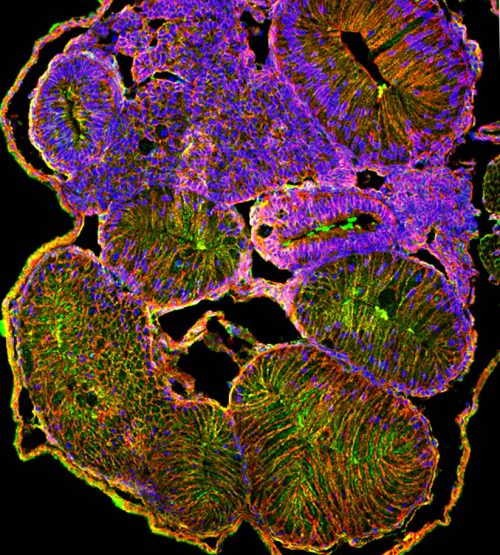Poorly coiled frog guts help scientists unravel prevalent human birth anomaly
Posted by Joyce Yu, on 22 February 2024
A press release related to the Research Article in Development “Developmental regulation of cellular metabolism is required for intestinal elongation and rotation“.
How does our intestine, which can be at least 15 feet long, fit properly inside our bodies? As our digestive system grows, the gut tube goes through a series of dramatic looping and rotation to package the lengthening intestine. Failure of the gut to rotate properly during development results in a prevalent, but poorly understood, birth anomaly called intestinal malrotation. Now, in a study published in the journal Development, scientists from North Carolina State University have uncovered a potential cause of this life-threatening condition.
Intestinal malrotation affects 1 in 500 births but the underlying causes are not well understood. To find out why gut revolution could go amiss, scientists need to first understand intestinal rotation during normal development, a complex process that still baffles biologists.
The team of scientists, led by Dr Nanette Nascone-Yoder, decided to make use of a well-established system in frogs. “As vertebrates, frogs and humans share a common ancestor and have many similar anatomical features, including an intestine that rotates in a counter-clockwise direction,” explained Dr Nascone-Yoder. “Because frog embryos develop in only a few days and are highly experimentally accessible, they allow us to quickly test new hypotheses about how and why development goes awry during malrotation.”
“Frog embryos develop in a petri dish and are transparent when the intestine is developing, so they can be exposed to drugs or environmental chemicals to screen for substances capable of producing malrotation,” said Dr Nascone-Yoder. One of the compounds the team screened was the herbicide atrazine. They found that exposure to atrazine greatly increased the frequency at which frog intestines rotated in the reverse (clockwise) direction and decided to focus on atrazine to further investigate intestinal malrotation.

Dr Julia Grzymkowski, who led the experimental work of this study, found that exposure to atrazine disrupted metabolism (chemical reactions that provide energy for biological processes) in the frog embryos. Metabolic imbalance in the embryos derailed a series of cellular processes in the gut — cells could not grow, divide and rearrange appropriately to drive the proper intestinal elongation and rotation.
“Although we found that atrazine causes malrotation in frogs, these results do not necessarily mean that this herbicide causes malrotation in humans, because, in our screen, the tadpoles were exposed to 1000-fold higher levels than are typically found in the environment,” Dr Nascone-Yoder emphasised, “but our findings do strongly suggest that disturbing the same cellular metabolic processes affected by atrazine, for example, via exposure to other chemicals in the environment and/or genetic variations that affect metabolism, could contribute to intestinal malrotation in humans.”
This study is just beginning to unravel what happens during embryonic development that leads to intestinal malrotation. Dr Nascone-Yoder’s team hopes to extend this work: “Our results have provided new avenues to explore the underlying causes of this prevalent birth anomaly. We are now starting to dive deeper into the cellular events that coordinate the complicated process of intestinal elongation and rotation.”
———-
To find out more about the story behind the paper, check out this interview we did with first author Julia Grzymkowski and corresponding author Nanette Nascone-Yoder.
———-
Reference: Grzymkowski, J.K., Chiu, M.Y., Jima, D.D., Wyatt, B.H., Jayachandran, S.M., Stutts, W.L., Nascone-Yoder, N.M. (2024) Developmental regulation of cellular metabolism is required for intestinal elongation and rotation. Development, 151, dev202020. doi:10.1242/dev.202020


 (No Ratings Yet)
(No Ratings Yet)